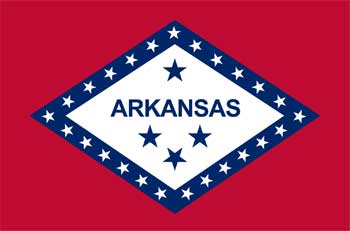Arkansas Emergency Vehicle Light State Statutes
 That custom flashing light kit may look cool on an online site, but bear in mind the only thing you can use it for in Arkansas is room decor. Arkansas has specific laws for emergency vehicle lighting and its state patrol and local police departments enforce the law regularly.
That custom flashing light kit may look cool on an online site, but bear in mind the only thing you can use it for in Arkansas is room decor. Arkansas has specific laws for emergency vehicle lighting and its state patrol and local police departments enforce the law regularly.
According to Arkansas State Code 27-36-301, anyone who affixes any type of rotating, flashing or oscillating light to their vehicle without being in one of the approved vehicle categories is automatically guilty of a Class A misdemeanor. The fine for the violation isn't as steep as other offenses, ranging between $10 and $100, depending on the case.
The law was implemented in 2010 to ensure that non-emergency drivers were not using lights similar to emergency lights. The law is meant to distinguish true emergency personnel from typical drivers. People have been known to use emergency lights for some private businesses and some even have used them to misrepresent themselves as law enforcement or other emergency personnel.
Arkansas emergency vehicle lights law has different categories of who can use emergency lighting on the road. There are basically four types of emergency lights allows for use in the state:
- Red lights
- Blue lights
- Yellow or amber lights
- Purple lights
Fire Trucks - Red Emergency Lights
Red lighting is used on fire trucks in the state of Arkansas. Fire trucks must use either the rotating or flashing warning lights and light bars. Firefighters may also put emergency lighting on their personal vehicles. This is to accommodate the number of volunteer firefighters serving in their communities around the state.
The lights can be either attached to the dash, rooftop or be a surface mount that attaches to the vehicle's exterior.
Two other groups of emergency vehicles may use the red flashing, oscillating or rotating lights. According to the statute, ambulances may also use that type of light. Medical professionals are also allowed to use either dash or surface mount red flashing or rotating lights on their personal vehicles provided the Arkansas Department of Health has given them permission.
Tow trucks are also allowed to use the red emergency lighting system, either flashing or rotating dash or surface mounts. However, the law states that tow trucks may only use emergency lighting while they initiating a vehicle tow or collecting a vehicle. They must turn off emergency lighting once the vehicle is secured on the tow truck.
Blue Emergency Lights for Police and Law Enforcement
Blue lights are meant only for law enforcement around the state. All law enforcement vehicles, including those used by state troopers and those used by local police departments, must use only the flashing, rotating, or blue strobe lights. There will not be a police vehicle using both red and blue flashing or rotating police lights. Those setups were discontinued years ago.
Amber or White Emergency Lights for Security, Construction, Pilot Escort Vehicles, and Tow Trucks
 Some private vehicles may use emergency lights under the Arkansas law. Some approved construction vehicles may use white or amber warning lights, as well as some publicly and privately owned vehicles used in situations that are potentially dangerous to drivers.
Some private vehicles may use emergency lights under the Arkansas law. Some approved construction vehicles may use white or amber warning lights, as well as some publicly and privately owned vehicles used in situations that are potentially dangerous to drivers.
Additionally, escort or pilot cars must use amber lights. The law stipulates those lights must be either strobe, incandescent or halogen lights. The other vehicle type allowed to use amber lights are school buses.
Purple Emergency Lights for Funeral Processions
Purple lights are those designated specifically for those leading a funeral procession, which largely will be private vehicles designated by the funeral home. The purple lights can be either oscillating, flashing or rotating. However, drivers may only use them during the procession and must be turned off all other times.
The big takeaway is to be careful what you use if you are customizing your vehicle. State law also doesn't allow the use of red, blue or green lights in the center front section of your vehicle while commuting. Standard non-emergency vehicles may use flashing lights along the roadside to indicate an emergency as a warning to other drivers, but not as ongoing lighting.
Additionally, any extra custom lights on your car, truck, SUV, van or minivan, with more an intensity of more than 300 candlepower must not strike the road any further than 75 feet away from your vehicle. Lights that function with the car, like headlights, turn signals, emergency warning lamps and headlights are not subject to this restriction.
Even white emergency lights are restricted on personal vehicles. Non-emergency drivers can't have more than two decorative LEDs with white lights mounted to the front of a vehicle. So, rows of spotlights many use for nighttime camping are not allowed on the vehicle's front.
There are rules about customizing the rear of non-emergency vehicles as well. Neon lights are forbidden as well as emergency type of lighting. However, you do have some variety in stop lamps, rear turn lights, hazard lights and reflectors. You may use blue dot trail lights for any of those purposes.
While some of these custom light kits look really cool, it's best to stay within Arkansas state law or you best be prepared to pay fines and being required to take them off your vehicle.
For more information about what lights may be available to you, we suggest calling your State Highway Patrol office at: 501-69-2421
*Please note that these numbers are what we are currently able to find and the numbers may have changed since this listing.
Disclaimer: The emergency vehicle light state statute guide was created by Extreme Tactical Dynamics as a guide and reference. We make no claim to the accuracy or validity of this guide. This guide was written to the best of our knowledge and has been provided to our customers as a courtesy ONLY! The information in this guide is our interpretation of the law as we have read it. We cannot be held responsible for any errors as this is only our interpretation of the law and the laws are constantly changing. We cannot be held liable or responsible for any errors and recommend that our customers refer to their local authorities to confirm the particular statue that governs their use of emergency vehicle lights.
 Facebook
Twitter
Google+
Instagram
YouTube
Facebook
Twitter
Google+
Instagram
YouTube


